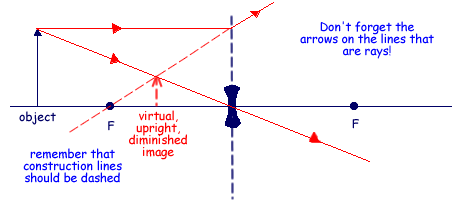Solutions: Medical Option - the EYE
Q10.
(a) The diverging lens in the figure below forms an image of the object.

Complete the figure by drawing a ray diagram to show the formation of the image. Label the image.
- ray diverging from F

- ray through centre of lens to form labelled image

(2 marks)
(b) A diverging spectacle lens of power –3.0 D is used to correct a defect of vision. When used to view a real object, the image is formed 0.21 m from the lens.
(i) State the defect of vision.
Myopia or short sight 
(ii) Calculate the distance of the object from the lens.
P = 1/f = 1/u + 1/v
-3.0 = 1/u - 1/0.21 
1/u = 1/0.21 - 3.0 = 1.76
u = 0.57 m 
(3 marks)
(Total 5 marks)
